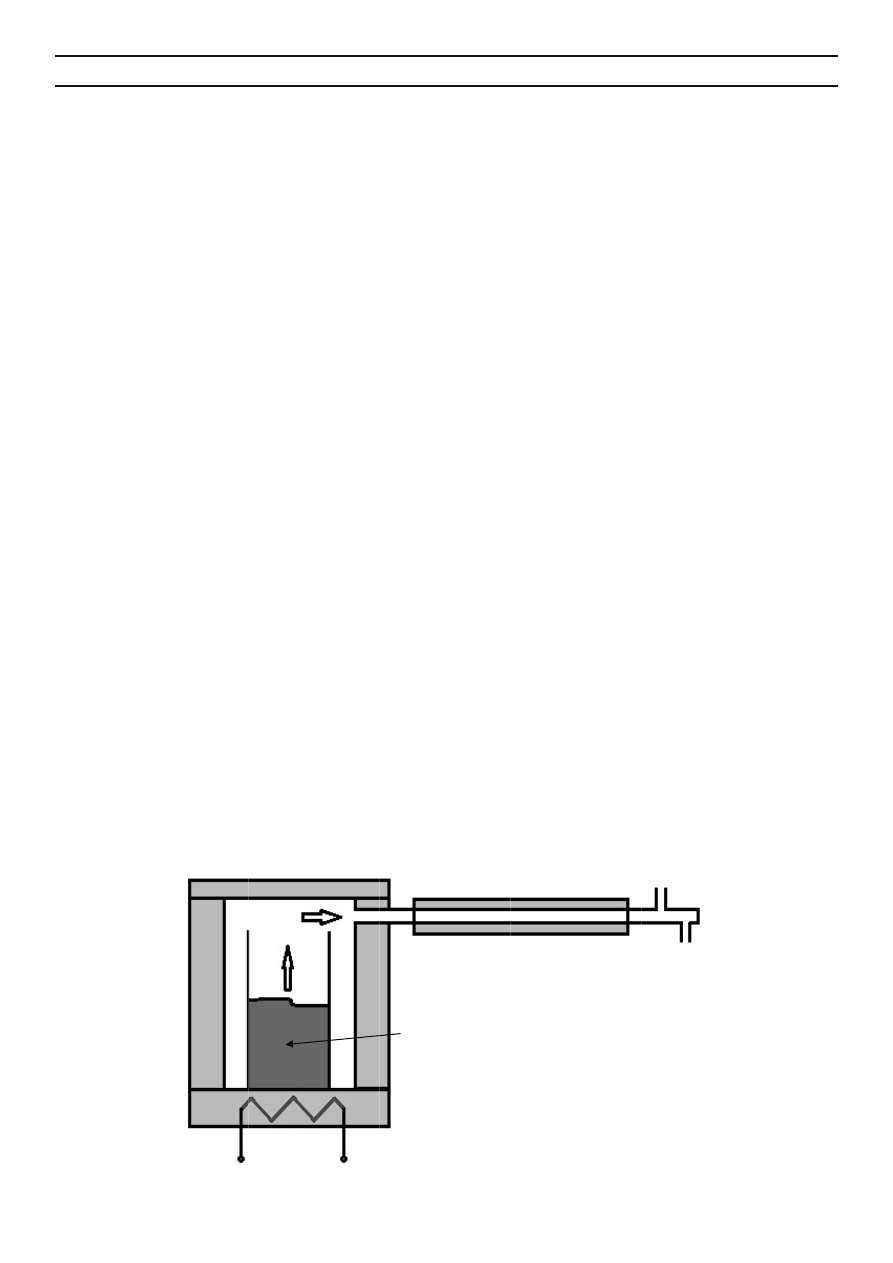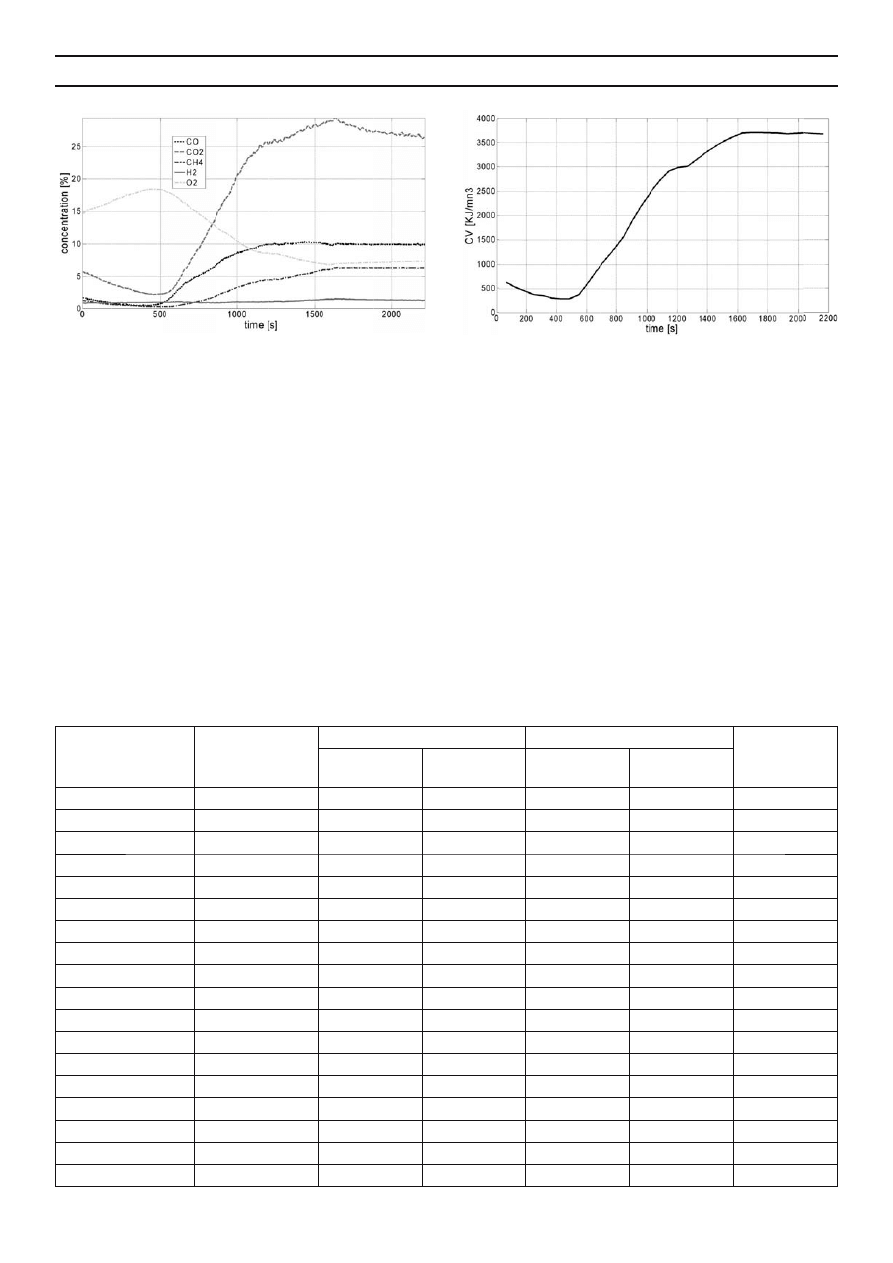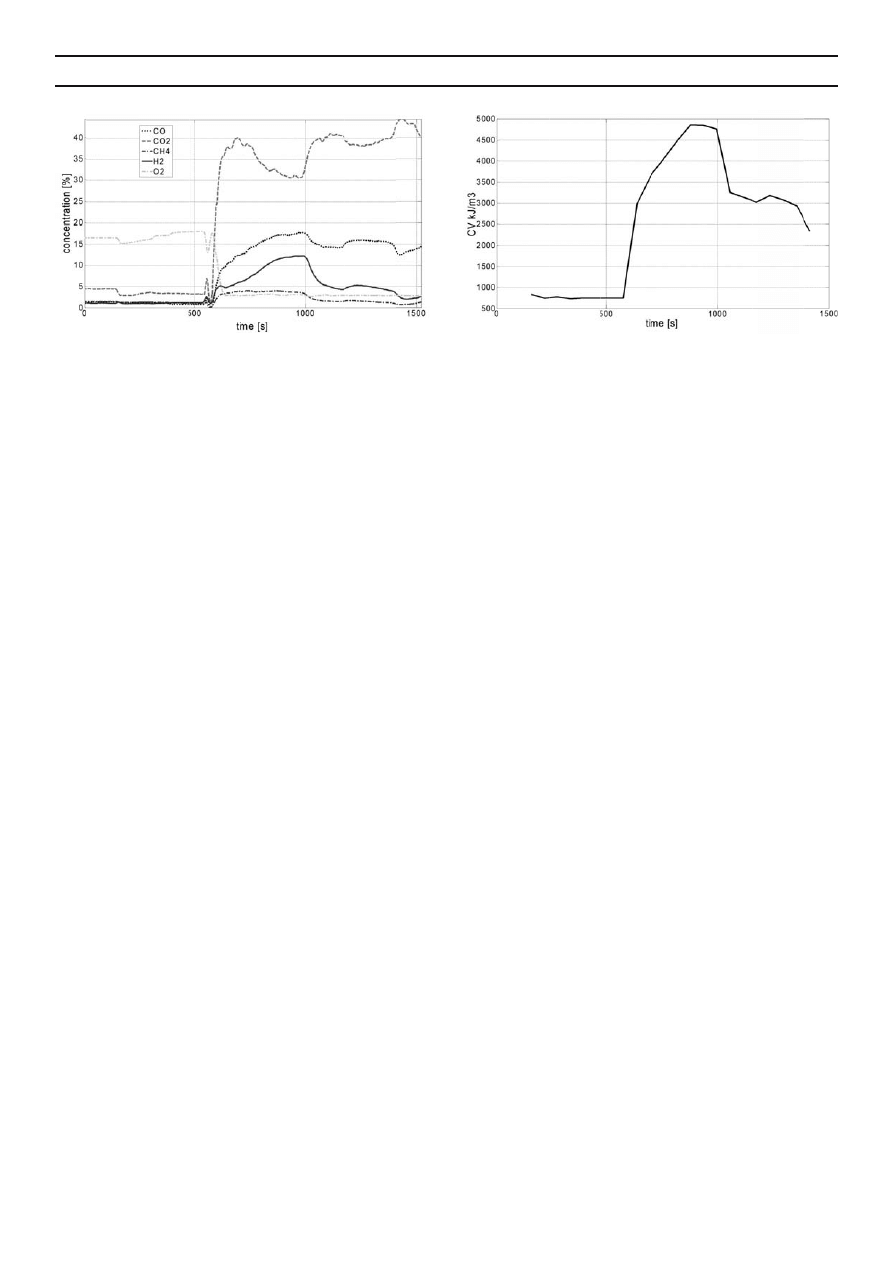
Introduction
Anaerobic digestion (AD) and biogas production are
promising ways to achieve energy and environmental benefits
at both the local and global level (Börjesson and Berglund
2006, Börjesson and Berglund 2007, Turkiewicz et al. 2013).
Biogas plants can provide an alternative energy source for
rural households and mitigate environmental emissions from
agricultural activities (Chen and Chen 2012, Kogut et al. 2014,
Prochnow et al. 2009). AD technology is unique because it can
simultaneously be used for waste treatment, for production of
renewable energy and for obtaining digestate, which can be
used as organic fertilizer, replacing mineral fertilizers that
require fossil energy.
However, some logistical problems can be identifi ed.
The increasing number of biogas plants especially larger ones
generating more than 500 kW of electrical power results in
larger transportation distances both on the input side (biomass
feedstock) and on the output side (digestate). To solve the
problem of digestate transportation there are several different
ideas. One suggestion is that the most common way to utilize
digestate from agricultural biogas plants is returning it with all
containing nutrients directly to the agricultural environment.
Anaerobic digestion residue represents a nutrient rich
resource which, if applied back on land, can reduce the use
of mineral fertilizers and improve soil fertility. This solution
is justifi ed by the fact that digestate constituents produced
during acidogenesis with particles of cellulose and lignin do
not undergo complete biodegradation. Another reason is that
the mineral components of digestate (nitrogen, phosphorus,
micronutrients) generated during methanogenesis determine
the fertilization value of digestate. Many reports point to the
benefi cial effect of digestate on soil and plant productivity
(Badran 2001, Garg et al. 2005, Zaid et al. 2005). There are
several problems concerning use of digestate as a soil fertilizer.
Firstly, an accumulation of biogas plants in certain
regions might lead to an oversupply of digestate especially in
regions with intensive livestock farming or fermentation of
organic residues and bio-waste. If the agricultural area is too
small for adequate use of the digestate, surplus material has to be
transported to regions with nutrient deficits, or other solutions
must be found (Rehl and Müller 2011). However, excessive
nitrogen content in digestate can be a problem due to European
Union standards. Limited applicability of digestate as fertilizer
may appear, especially in winter, during the vegetation period
or when there is advanced eutrophication of arable land and
adjacent waters (rivers, lakes). For optimal deployment of
fermentation residue as fertilizer, the application limit for
nitrogenous fertilizer of 170 kg nitrogen per hectare has been
determined (Commission of the European Communities 1991).
Archives of Environmental Protection
Vol. 41 no. 3 pp. 70–75
PL ISSN 2083-4772
DOI 10.1515/aep-2015-0032
© Copyright by Polish Academy of Sciences
and Institute of Environmental Engineering of the Polish Academy of Sciences,
Zabrze, Poland 2015
The pyrolysis and gasifi cation of digestate from agricultural
biogas plant
Dariusz Wiśniewski
1
, Janusz Gołaszewski
1
, Andrzej Białowiec
2
*
1
University of Warmia and Mazury, Poland
Research Center for Renewable Energy
2
University of Environmental and Life Sciences
Faculty of Life Sciences and Technology
Institute of Agricultural Engineering
*
Corresponding author’s e-mail: andrzej.bialowiec@up.wroc.pl
Keywords: anaerobic digestion, digestate, fertilizer, drying, pyrolysis, gasifi cation.
Abstract: Anaerobic digestion residue represents a nutrient rich resource which, if applied back on land, can
reduce the use of mineral fertilizers and improve soil fertility. However, dewatering and further thermal processing
of digestate may be recommended in certain situations. Limited applicability of digestate as fertilizer may appear,
especially in winter, during the vegetation period or in areas where advanced eutrophication of arable land and
water bodies is developing. The use of digestate may be also governed by different laws depending on whether it
is treated as fertilizer, sewage sludge or waste. The aim of this paper is to present the effects of thermal treatment
of solid fraction of digestate by drying followed by pyrolysis and gasifi cation. Pyrolysis was carried out at the
temperature of about 500°C. During this process the composition of fl ammable gases was checked and their
calorifi c value was assessed. Then, a comparative analysis of energy parameters of the digestate and the carbonizate
was performed. Gasifi cation of digestate was carried out at the temperature of about 850°C with use of CO
2
as
the gasifi cation agent. Gasifi cation produced gas with higher calorifi c value than pyrolysis, but carbonizate from
pyrolysis had good properties to be used as a solid fuel.
Brought to you by | Uniwersytet Warminsko Mazurski
Authenticated
Download Date | 2/23/16 8:58 AM

The pyrolysis and gasifi cation of digestate from agricultural biogas plant 71
Another, environmental, problem with digestate
utilization for soil improvement can be found, especially
during land application of a raw digestate. NH
3
and odors
emission mainly happens after field application of fermentation
residues (Amon et al. 2006). After field applications, over
70% of nitrogen can be lost (Bauer et al. 2009). In comparison
to untreated liquid manure, fermentation residues are
characterized by a much lower content of dry matter. A high
risk for increased ammonia losses can be expected as a result
of the high pH-value (around 8.0 units) in fermentation
residues, which influences the NH
3
volatilization (Pötsch et
al. 2004).
Moreover, another odor problems appear when
conventional digestate management based on its storage in
open tanks, chambers and field application is implemented
(Sandars et al. 2003, Voca et al. 2005).
Unfortunately, the high water content of the residue
somewhat reduces the value as large volumes have to be stored,
transported and land applied. Finally, the post-production
residue – digestate is considered to be hardly manageable
waste, although it can also be perceived as valuable material
whose potential for further conversion has not been revealed
yet.
To reduce water and nitrogen content several
procedures have been implemented, mostly based on digestate
drying with the use of: belt dryers, drum dryers, solar dryers
(greenhouses), evaporators, and thermal dryers (Rehl and
Müller 2011). For the mentioned methods the following issues
were investigated: quality of digestate (presence or absence of
toxic compounds), ecological requirements (safe application),
development of new products, low energy consumption
and high economic effi ciency of a biogas plant (minimizing
operations costs).
The digestate drying overcomes logistical and
environmental problems appearing when conventional
techniques of digestate management are used. Additionally,
digestate drying brings several new approaches to utilize the
digestate for energy production, second generation solid fuel
production, and biochar production for soil improvement,
which are under investigation. Among numerous examples
of such studies, some novel approaches are distinguishable,
i.e. use of dehydrated digestate to produce biochar through
torrefaction process (Wiśniewski et al. 2012) or other thermal
treatment processes: pyrolysis and gasifi cation (Wiśniewski
and Gołaszewski 2013).
Accordingly, in order to allow better comparison of
these methods we asked which thermal treatment method,
namely pyrolysis or gasifi cation, has a greater potential for
dewatered digestate energy production. Therefore, the purpose
of this study has been to determine the energy generation
potential of digestate from an agricultural biogas plant, in
which the main substrates are cattle manure and maize silage,
subjected to pyrolysis and gasifi cation.
Materials and methods
Digestate from a pilot biorefi nery located at the Experimental
Station in Bałdy, Poland (N53° 36' 1.8073", E20° 36' 8.5295")
was used in this research. The technological parameters of
fermentation were as follows:
– feedstock moisture 90%;
– the total batch fed to a digester 1.2 m
3
;
– the total load of organic compounds 2.3 kg VS/m
3
;
– the set temperature during the fermentation process
35–40°C;
– residence time in the pre-fermentation tank 3 days;
– residence time in the fermentation chamber 20 days;
– residence time in the post-fermentation tank 20
days.
A sample of 30 dm
3
of the dry digestate (10% moisture
content) was collected from the biogas plant. Drying was done
in thermal evaporator associated to biogas plant.
The pyrolysis and gasifi cation of dried digestate
processes were performed in a batch reactor (Fig. 1).
The batch reactor consisted of a sealed chamber with
an electrically heated bottom and a gaseous products cooler. As
a cooling medium, circulating water was used. The reactor was
equipped with a process temperature control system within
Fi
ig. 1. The coonstruction
Batch react
Power supp
of pyrolysi
tor
ply
is/gasificatio
Feedsto
on batch rea
Cool
ock
actor
ing pipe
S
Syngas
Condensaate
Fig. 1. The construction of pyrolysis/gasifi cation batch reactor
Brought to you by | Uniwersytet Warminsko Mazurski
Authenticated
Download Date | 2/23/16 8:58 AM

72
D. Wiśniewski, J. Gołaszewski, A. Białowiec
the range of about 1000°C. Dried digestate was fed into the
reactor through the top cover and then thermally processed
in the heating chamber. Two thermal treatment methods
pyrolysis, and gasifi cation were applied. The gaseous products
of processes were then cooled and condensed in a pipe cooler.
The process parameters in the reactor were measured and
recorded in real time. Gaseous products of pyrolysis and
gasifi cation composition was determined [% v/v] in range of:
carbon oxide (CO), carbon dioxide (CO
2
), methane (CH
4
),
hydrogen (H
2
), and oxygen (O
2
). Changes of calorifi c value
[kJ/Nm
3
] of gaseous products were monitored.
Pyrolysis was carried out at 500°C. Gasifi cation of
digestate was carried out at 850°C with use of CO
2
as the
gasifi cation agent. Pyrolysis was carried for 2000 s, but the
duration of gasifi cation was 1500 s. Before feeding digestate,
the reactor was pre-heated to 850°C. Once a sample of
digestate was inside and the process of gasifi cation started, the
chosen gasifi cation agent CO
2
was fed into the reactor with the
volumetric fl ow 0.004 m
3
/h.
The comparative analysis of energy parameters of the
digestate and the pyrolysis product – carbonizate was performed.
Digestate, and carbonizate samples were taken and analyzed in
the same range of parameters. The following parameters of solid
materials were determined: moisture/dry mass (DM), content of
nitrogen, carbon, hydrogen, and sulphur, as well as lower and
upper heating values, combined carbon, gaseous particles and
ash.
Moisture was determined gravimetrically at 105±2°C
in a Binder dryer. Dry samples were ground in laboratory mills
IKA MF 10 to a size below 0.25 mm. In that form the samples
were analyzed for determination of analytical moisture, ash
content, and loss on ignition by TGA ELTRA THERMOSTEP
thermogravimetric analyzer. The high heating value was
determined with IKA Werke GmbH C2000 calorimeter. The
low heating value was calculated according to the moisture and
hydrogen content using following equation:
H
l
= H
h
– 24.42 · (8.94 · H – W)
Where:
Hh – high calorifi c value determined analytically (kJ/kg),
H – measured hydrogen content in the solid sample (%),
W – measured moisture content in the solid sample (%),
24.42 – water vaporization heat in standard condition related
to 1 % of water generated during sample combustion (kJ/kg),
8.94 – coeffi cient of hydrogen content calculation on water.
Dry solids (DM), lower heating values (LHV) and
upper heating values (UHV) were expressed also as dry, ash
free basis (daf): LHV(daf), UHV(daf), respectively.
For determination of nitrogen content, Kjeldahl
method was used. Carbon, hydrogen, and sulfur in the samples
were determined using CHS500 ELTRA elemental analyzer.
Metals: Ca, K, Na, Fe, Mn, Cu, Zn were analyzed in Zeeman
Atomic Absorption Spectrometer AA280Z coupled with
GTA-120 Graphite Tube Atomizer Varian GTA-120. H/C ratio
of digestate and carbonizate was determined.
The elements of mass and energy effi ciency validation
were estimated. Mass yield of pyrolysis Y
M
, was calculated
by considering weight loss during pyrolysis, also expressed
as dry, ash free basis. The mass yield is defi ned by equations
(Kim et al. 2012):
ܻ
ெ
ൌ
ͳͲͲ ȉ ܦܯ
ܦܯ
ௗ
ܻ
ெሺௗሻ
ൌ
ͳͲͲ ȉ ܦܯ
ሺௗሻ
ܦܯ
ௗሺௗሻ
where:
Y
M
– mass yield [%]
Y
M(daf)
– mass, dry, ash free basis yield [%]
DM
c
– dry mass of carbonizate [g],
DM
d
– dry mass of digestate [g],
DM
c(daf)
– dry, ash free basis mass of carbonizate [g],
DM
d(daf)
– dry, ash free basis mass of digestate [g].
Energy yield (Y
E
) per dry raw material indicates the
total energy preserved in the carbonizate. The energy yield, on
dry, ash free basis (daf), indicates the energy content of raw
digestate retained in the carbonized solid (Kim et al. 2012).
This was calculated using the following equation:
ܻ
ா
ൌ
ܻ
ெሺௗሻ
ȉ ܷܪܸሺ݂݀ܽሻ
ܷܪܸሺ݂݀ܽሻ
ௗ
where:
Y
E
– energy yield [%]
Y
M(daf)
– mass, dry, ash free basis yield [%]
UHV(daf)
c
– upper heating value of dry, ash free basis
carbonizate [MJ/kg DM(daf)]
UHV(daf)
d
– upper heating value of dry, ash free basis digestate
[MJ/kg DM(daf)]
Results and discussion
Prior to placing digestate, the reactor was preheated to about
580°C, which corresponds to the range of conventional
pyrolysis (Yaman 2004). During the pyrolytic process at 500°C,
changes in concentrations of particular gases were monitored
as well as changes in the calorifi c value of pyrolytic gas in
time (Fig. 2, 3). The proper pyrolytic processing started at the
time point of t=500 s, when quantities of fl ammable gases such
as carbon oxide (CO), methane (CH
4
) and, to a lesser extent,
hydrogen (H
2
) increased signifi cantly. After 1500 s, when gas
composition became relatively constant (24% of CO
2
, 10% of
CO, 8 % of CH
4
, and 2 % of H
2
) (Fig. 2), the plateau of gas
calorifi c value about 3700 kJ/Nm
3
was achieved (Fig. 3).
Dried digestate and produced carbonizate were
analyzed in terms of their chemical composition and calorifi c
value. The experimental results showed the considerable
accumulation of ash, from 26.62% in digestate to 49.55% in
carbonizate, and combined carbon from 14.7% in digestate to
30.27% in carbonizate (Tab. 1). This phenomenon may be the
consequence of the fact that large amounts of carbon found in
the biodegradable fraction of organic matter are bound during
methane fermentation, so consequently hardly degradable
carbon compounds (e.g. lignin) remain in digestate. During
pyrolysis, reduction of residual moisture occurs, volatile
fractions are evaporated and carbon is converted into molecules
of higher molecular weight. Carbonizate was characterized by
lower heat of combustion and calorifi c value than digestate
(16.6% and 11.9% lower, respectively). It could be caused
Brought to you by | Uniwersytet Warminsko Mazurski
Authenticated
Download Date | 2/23/16 8:58 AM

The pyrolysis and gasifi cation of digestate from agricultural biogas plant 73
by water, volatile compounds and CO releasing (Prins et al.
2006). When considering the content of ash in dry matter, the
energy value of carbonizate was higher about 21–28% than in
digestate (Tab. 1). In turn, the content of sulphur, nitrogen and
chloride was decreased signifi cantly during pyrolysis (46%,
28.2% and 27.9%, respectively). The mass yield and energy
yield of digestate pyrolysis were 43,3, and 52,5%, respectively
(Tab. 1). Additionally, about 59% decrease of H/C ratio from
1.41 to 0.58 was observed. Usually, for biomass containing
lignin H/C ratio is higher than 0.9 (Kim et al. 2012, Roussetet
al. 2012, Wannapeera and Worasuwannarak 2012).
In the case of experiment on dried digestate
gasifi cation, the proper process began after 600 seconds, when
reactions typical for gasifi cation commenced (degasifi cation
of the fed batch in the sphere of pyrolysis). From that
moment, carbon dioxide was supplied to the reactor, and the
concentration of fl ammable gases, especially CO and H
2
and,
to a lesser extent, CH
4
started to rise (Fig. 4). At the same time,
the concentration of oxygen decreased distinctly. The process
of gasifi cation terminated at t=1000 s. The high concentration
of CO
2
which persisted until that moment was due to the fact
that the gasifi cation agent, i.e. CO
2
, continued to be supplied.
This gas reduced CO
2
in the reduction zone to CO. The highest
calorifi c value of the generate gas coincided in time with the
maximum concentration of all fl ammable gases: CO, H
2
, and
CH
4
(34 % in total), which took place at t=900 s (Fig. 4). The
calorifi c value recorded then was 5 kJ/Nm
3
(Fig. 5), and was
higher than in the case of pyrolysis.
Fig. 2. Changes in concentrations of gaseous products
generated during pyrolysis of dried digestate
Fig. 3. Changes in calorifi c value (CV) [kJ/Nm
3
]
of pyrolytic gas
Table 1. Calorifi c and chemical parameters of digestate and carbonizate after pyrolysis
Specifi cation
Unit
Digestate
Carbonizate
Change
in %
Mean
Standard
deviation
Mean
Standard
deviation
Moisture %
7.85
0.087
3.27
0.021
-58.3
UHV GJ/Mg
DM
16.86
0.038
14.06
0.027
-16.6
UHV(daf)
GJ/Mg DM (daf)
22.97
0.041
27.87
0.036
+21.3
LHV
GJ/Mg DM
15.34
0.049
13.52
0.027
-11.9
LHV(daf)
GJ/Mg DM (daf)
20.90
0.045
26.80
0.029
+28.2
Combined carbon
% DM
14.7
0.070
30.27
0.066
+105.9
Volatile ingredients
% DM
58.67
0.273
20.18
0.125
-65.6
Ash
% DM
26.62
0.336
49.55
0.085
+86.1
C
% DM
39.68
0.078
35.93
0.573
-9.5
H
% DM
4.65
0.029
1.75
0.047
-62.4
S
% DM
0.87
0.006
0.47
0.010
-46.0
N
% DM
3.76
0.040
2.7
0.020
-28.2
Cl
% DM
0.43
0.010
0.31
0.012
-27.9
O
% DM
23.98
0.278
9.29
0.662
-61.3
H/C
–
1.41
0.06
0.58
0.04
-58.9
Y
M
%
–
–
63.0
3.2
–
Y
M
(daf)
%
–
–
43.3
2.7
–
Y
E
%
–
–
52.5
4.1
–
DM – dry matter
Brought to you by | Uniwersytet Warminsko Mazurski
Authenticated
Download Date | 2/23/16 8:58 AM

74
D. Wiśniewski, J. Gołaszewski, A. Białowiec
Summary
Fractionation of digestate and use of its solid phase for
generation of energy is one of the alternative uses of this
anaerobic digestion byproduct. This solution creates a certain
potential for using digestate in production of the 2
nd
generation
biofuels from pyrolysis: carbonizate and pyrolitic gas.
Carbonizate may be reused either as a fuel or fertilizer in form
of biochar. Pyrolitic gas is usually recycled and used for heating
the pyrolytic reactor. Gasifi cation leads to generation of more
calorifi c gas and ash which can be used as soil amendments or
fertilizer. The high ash content in dried digestate may cause
problems with slag often vitrifying during gasifi cation, but this
problem requires further investigation.
Acknowledgments
The paper has been written under the strategic program of
the National (Polish) Centre for Research and Development
(NCBiR): “Advanced Technologies for Energy Generation.
Task 4: Elaboration of Integrated Technologies for the
Production of Fuels and Energy from Biomass, Agricultural
Waste and other Waste Materials.”
References
Amon, B., Kryvoruchko, V., Amon, T. & Zechmeister-Boltenstern, S.
(2006). Methane, nitrous oxide and ammonia emissions
during storage and after application of dairy cattle
slurry and influence of slurry treatment, Agriculture.
Ecosystems, and Environment, 112, pp. 153–162.
Badran, N.M. (2001). Residual effect of nutrient-enriched organic
residues on growth and nutrient utilization by corn
plants grown on a sandy soil, Annals of Agricultural
Science, Moshtohor, 39, 1, pp. 717–736.
Bauer, A., Mayr, H., Hopfner-Sixt, K.,& Amon, T. (2009). Detailed
monitoring of two biogas plants and mechanical solid-
-liquid separation of fermentation residues, Journal
Biotechnology, 142, pp. 56–63.
Börjesson, P. & Berglund, M. (2006). Environmental systems analysis
of biogas systems – Part I: fuel-cycle emissions,
Biomass and Bioenergy, 30, pp. 469–485.
Börjesson, P. & Berglund, M. (2007). Environmental systems analysis
of biogas systems – Part II: the environmental impact
of replacing various reference systems, Biomass and
Bioenergy, 31, pp. 326–344.
Chen, S.Q. & Chen, B. (2012). Sustainability and future alternatives
of biogas-linked agrosystem (BLAS) in China: an
energy-based analysis, Renewable & Sustainable
Energy Reviews, 16, 6, pp. 3948–3959.
Commission of the European Communities (1991). Council Directive
91/676/EEC of 12
th
December 1991 concerning the
protection of waters against pollution caused by nitrates
of agricultural origin, Official Journal of the European
Communities L375.
Garg, R.N., Pathak, H., Das, D.K. & Tomar, R.K. (2005). Use of fl y
ash and biogas slurry for improving wheat yield and
physical properties of soil, Environmental Monitoring
and Assessment, 107, 1/3, pp. 1–9.
Kim, Y.H., Lee, S.M., Lee H.W. & Lee, J.W. (2012). Physical
and chemical characteristics of products from the
torrefaction of yellow poplar (Liriodendron tulipifera),
Bioresource Technology, 116, pp. 120–125.
Kogut, P., Piekarski, J., & Ignatowicz, K. (2014). Start-up of biogas
plant with inoculating sludge application, Rocznik
Ochrona Środowiska, 16, pp. 534–545.
Prins, M.J., Ptasinski, K.J. & Janssen, F.J.J.G. (2006). More effi cient
biomass gasifi cation via torrefaction, Energy, 31, 15,
pp. 3458–3470.
Prochnow, A., Heiermann, M., Plöchl, M., Linke, B., Idler, C., Amon,
T. & Hobbs, P.J. (2009). Bioenergy from permanent
grassland – A review: 1. Biogas, Bioresource Technology,
100, pp. 4931–4944.
Pötsch, E.M., Pfundtner, E. & Much, P. (2004). Nutrient content
and hygienic properties of fermentation residues
from agricultural biogas plants. Land use systems in
grassland dominated regions. Proceedings of the 20
th
General Meeting of the European Grassland Federation,
Luzern, Switzerland, 2004, pp. 1055–1057.
Rehl, T. & Müller, J. (2011). Life cycle assessment of biogas digestate
processing technologies, Resources, Conservation, and
Recycling, 56, pp. 92–104.
Rousset, P., Macedo, L., Commandré, J.M. & Moreira, A. (2012).
Biomass torrefaction under different oxygen
concentrations and its effect on the composition of the
solid by-product, Journal of Analytical and Applied
Pyrolysis, 96, pp. 86–91.
Sandars, D.L., Audsley, E., Canete, C., Cumby, T.R., Scotford, I.M.
& Williams, A.G. (2003). Environmental benefits of
livestock manure management practices and technology
by Life Cycle Assessment, Biosystems Engineering, 84,
pp. 267–281.
Turkiewicz, A., Brzeszcz, J., & Kapusta, P. (2013). Preliminary
tests of biogas microbiological purity in order to asses
Fig. 4. Changes in concentrations of gaseous products
generated during gasifi cation of dried digestate
Fig. 5. Changes in calorifi c value (CV) [kJ.Nm
3
] of gas
generated during gasifi cation of dried digestate
Brought to you by | Uniwersytet Warminsko Mazurski
Authenticated
Download Date | 2/23/16 8:58 AM

The pyrolysis and gasifi cation of digestate from agricultural biogas plant 75
a possibility of its input into a gas system, Rocznik
Ochrona Środowiska, 15, pp. 515–523.
Voca, N., Kricka, T., Cosic, T., Rupic, V., Jukic Z. & Kalambura,
S. (2005). Digested residue as a fertilizer after the
mesophilic process of anaerobic digestion, Plant, Soil,
and Environment, 51, pp. 262–266.
Wannapeera, J. & Worasuwannarak, N. (2012). Upgrading of woody
biomass by torrefaction under pressure, Journal of
Analytical, and Applied Pyrolysis, 96, pp. 173–180.
Wiśniewski, D., Gołaszewski, J., Białowiec, A. & Gołaszewski, M.
(2012). Torrefaction of turkey manure and energy value
of the product. International Workshop on Biomass
Torrefaction for Energy. Alby, 2012.
Wiśniewski, D. & Gołaszewski, J. (2013). Thermal treatment
of dewatered digestate for energy use. Mat. Conf.
International Anaerobic Digestion Symposium at
Biogas World 2013, Berlin, 2013.
Yaman, S. (2004). Pyrolysis of biomass to produce fuels and chemical
feedstocks, Energy Conversion, and Management, 45,
5, pp. 651–671.
Zaid, M.S., Ghozoli, M.A. & Lamhy, M.A. (2005). Residual effect
of some organic residues produced from biogas on
growth and nutrients utilization by wheat plants,
Annals of Agricultural Science, Moshtohor, 43, 2,
pp. 955–972.
Piroliza i gazyfi kacja pofermentu z biogazowni rolniczych
Streszczenie: Pozostałości z biogazowni rolniczych stanowią bogaty w substancje nawozowe surowiec, w przy-
padku którego, jego rolnicze wykorzystanie, może zmniejszyć stosowanie nawozów mineralnych i poprawić wła-
ściwości gleby. Jednakże poferment powinien być wcześniej odwodniony i przetworzony termicznie. Ograniczona
stosowalność w środowisku przyrodniczym pofermentu może szczególnie wystąpić w okresie zimowym oraz
na terenach zagrożonych eutrofi zacją. Wykorzystanie pofermentu podlega także ograniczeniom prawnym w za-
leżności od tego czy jest traktowany jako nawóz, osad lub odpad. Celem artykułu jest przedstawienie efektów
zastosowania termicznego przetwarzania odwodnionego pofermentu w procesach pirolizy i zgazowania. Proces
pirolizy pofermentu prowadzono w temperaturze 500°C. Monitorowano skład i kaloryczność gazu pirolitycznego.
Wykonano porównawcze analizy kaloryczności odwodnionego pofermentu i uzyskanego w wyniku pirolizy kar-
bonizatu. Gazyfi kację prowadzono w temperaturze 850°C w atmosferze CO
2
. Wykazano, iż uzyskany w procesie
gazyfi kacji gaz syntezowy posiadał wyższą kaloryczność, jednak dodatkowy produkt procesu pirolizy – karboni-
zat posiadał dobre właściwości do wykorzystania jako paliwo stałe.
Brought to you by | Uniwersytet Warminsko Mazurski
Authenticated
Download Date | 2/23/16 8:58 AM
Wyszukiwarka
Podobne podstrony:
Wyklady Architektura Polska XXw, prof Stefanski doc
Badania separacji na frakcje stałą i ciekłą gnojowicy i pulpy pofermentacyjnej Polska 2014
Poferment jako alternatywa dla nawożenia mineralnego 2015 (Polska praca)
pytania z egzaminu pORTFEL iNWESTYCYJNY PROF OSTROWSKA RÓŻNE LATA 2012-2015, Semestr 2 UG, Portfel I
Ekonomia matematyczna egz 30.01.2015, Ekonomia II stopień, UMK 2013-2015, III semestr, Ekonomia mate
pyt-EM, Ekonomia II stopień, UMK 2013-2015, III semestr, Ekonomia matematyczna, prof. Stawicki
PYTANIA-ZWP, Studia WZR zarządzenie 2014-2015, ZWP- Prof. Pawłowicz
List otwarty w sprawie prof, Smoleńsk i Polska, Polska
Metodologia-zagadnienia 2014-2015(1), Filologia polska, Metodologia badań literackich
Opracowanie pytań, Studia WZR zarządzenie 2014-2015, ZWP- Prof. Pawłowicz
Polska neo kolonią wywiad z prof Witoldem Kieżunem
2015 12 20 Prof Roszkowski do Wałęsy i Borusewicza
Polska gospodarka jak w Burundi – Prof Witold Kieżun
Prof Piotr Jaroszyński Co się dzieje z Polską
więcej podobnych podstron